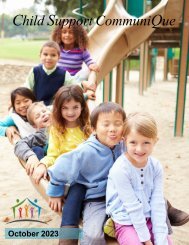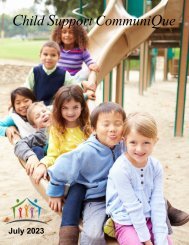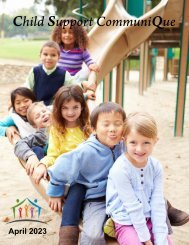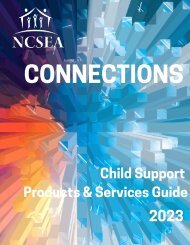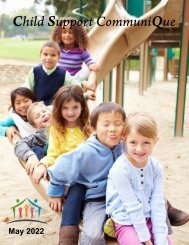April 2024 CSQ
You also want an ePaper? Increase the reach of your titles
YUMPU automatically turns print PDFs into web optimized ePapers that Google loves.
percent or more staffing cuts. OCSS also<br />
experienced significant funding cuts. My<br />
staff and I anxiously monitored new hire<br />
data. The program was not really back on<br />
its feet until 2012.<br />
Coming into office, I wanted to establish<br />
the vision, consensus, and policy<br />
framework for a family-centered program.<br />
My predecessors had laid the groundwork<br />
through policy guidance, grant projects, and<br />
initiatives like PAID. Texas was pioneering an<br />
impressive family-centered program model, and<br />
several other states and counties had implemented grant-funded initiatives.<br />
The problem was that these grant initiatives often were not seen as part of<br />
the “real” child support program, and were not sustained when the grant<br />
ended. I wanted to integrate family-centered policies and practices into the<br />
program. But with the fiscal crisis, few people were in the mood to hear<br />
about an upcoming shift in federal priorities.<br />
I remember one cab ride to a conference in 2010. My cabdriver told me that<br />
he could not make enough money driving cab during the recession to pay<br />
his child support. He wanted to go back to school to get an HVAC<br />
certificate. He said he regularly saw his children, and his former wife<br />
supported his plan. However, the county attorney had threatened him with<br />
jail if he quit. I told his story at the conference. The story was not wellreceived.<br />
Have a Plan B. I spent the recession years trying to describe the families I<br />
knew and the type of approaches that would work. I also focused on<br />
changing the language we used. To draw the picture, I borrowed familycentered<br />
principles and language from the child welfare field. I sketched out<br />
the “bubble chart” for a presentation slide. Much to my surprise, it became<br />
our logo. We began drafting the 2016 Flexibility, Efficiency, and<br />
Modernization rule early in the first term. As the program restabilized after<br />
the recession, federal, state, county, and tribal child support agencies<br />
engaged in extensive discussions about the program’s future. We stepped<br />
up federal research to deepen the evidentiary basis, including CSPED,<br />
Procedural Justice-Informed Alternatives to Contempt (PJAC), and<br />
Parenting Time Opportunities for Children (PTOC). We modernized our






